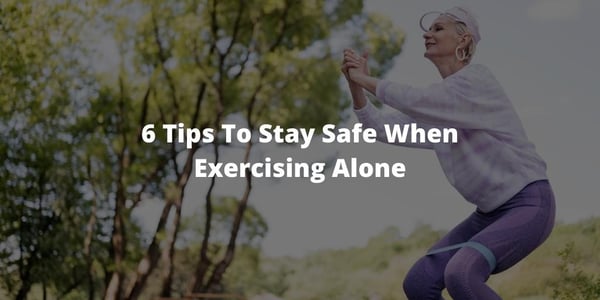Swimming is often considered one of the best exercise options. Typically children from an early age...
What To Do if You Fall
The CDC's latest statistics reveal an alarming trend among older adults in the United States - falling incidents. Shockingly, almost one-third (28%) of all adults aged 65 and above suffer falls each year, leading to approximately 36 million falls. The consequences of such falls are potentially devastating, ranging from minor injuries to life-altering disabilities, and even death. Consequently, it has become increasingly vital for older adults to learn and implement effective fall prevention techniques to minimize the risk of falling. However, despite best efforts, falls can still occur, and it is crucial to be equipped with the knowledge of how to handle such situations. By being well-informed and prepared, older adults can minimize the potential for serious harm after a fall.
What To Do If You Fall
You can easily suffer from bodily harm or a concussion after a fall. It's important to assess the situation immediately. One thing that will help you do this is checking yourself for injuries.
Before you even try to get up, you should seek to understand if your head or other body parts suffered injury. This will allow you to decide whether getting up will be safe or if it could lead to further problems.
After assessing yourself, you will have to consider two options. First, if you're not hurt, you can try to get yourself up. However, you should call for help if you're wounded. An injured leg or hip, for example, could lead to another fall if you cannot pull yourself up completely without pain.
How To Get Up Safely From A Fall
Here are the steps you should take if you've fallen but remain unhurt:
-
Roll To Your Side
Firstly, you should look for furniture such as a chair nearby to help you. Then, you should attempt to roll to your side toward the furniture. You can do this by turning your head in the direction you wish to roll. After that, move your shoulder, arms, hip, and leg in the same direction.
-
Be Still
Now that you have rolled, stay stationary for a few moments. This will allow your blood pressure to adjust and normalize. It's important not to rush to get up. Even if you are not injured, doing so can cause dizziness, which can make the situation worse.
-
Get Into A Side Sitting Position
When you feel ready, slowly lift your upper body and head upwards. Once again, you should rest for a few moments before moving on to the next step.
-
Reach The Furniture Piece
If you saw a furniture piece nearby in the first step, now is the time to crawl towards it. You should be on your hands and knees when moving to the item.
However, you must ensure that the furniture piece is stable and will support your weight. For instance, you could use the support of a sturdy chair. Of course, a sofa would be a better option. A lamp or barstool, for example, likely will not be stable enough to support the weight of a person.
-
Use The Furniture To Pull Yourself Up
Now you should kneel side-on towards the furniture piece with your strongest leg beside it. You should also slide the foot of this leg forward and ensure that it is flat on the ground.
At the same time, bend your other leg so that your knee touches the floor. Finally, put both hands on the furniture to get up slowly and turn your body so that you can sit on the sofa or chair.
-
Stay Seated
After sitting on the furniture piece, stay seated and think about how you're feeling. Typically, you should call for help or contact someone you know. Even if you don't feel injured, the pain may come later, or you could have suffered an internal injury.
What To Do If You Cannot Get Yourself Up
Sometimes you may consider your injury mild and try to get up. However, you may not be able to. The best option is to reach your phone and call for help in such a case. If you don't have a phone within reach, you should try reaching a window. Making noise will help you to gain attention.
You should remember some health tips while waiting for help. For instance, look for something soft to rest your head. Also, try to keep warm and keep moving if it is safe to do so. This will help you prevent yourself from becoming stiff.
How To Take Care Of Yourself After A Fall
Here are the top things you can do to take care of yourself after a fall:
-
Talk to a Doctor
The most important thing to do is visit a doctor for an examination. This will help you avoid preventable consequences. The doctor can also recommend medicine for pain and help you recover quicker.
You should also explain why you fell in the first place. For example, if you were dizzy before you fell, talk with your doctor about addressing the root of the problem.
-
Get Your Injuries Treated
If the doctor lets you know of an injury, be sure to get it treated as soon as possible. Avoid leaving the hospital without treatment because of fear, finances, or other reasons.
You may think that getting painkillers will help you survive. However, remember that minor injuries can turn serious quickly if you don't get suitable treatment.
-
Rest
An essential thing that most people don't do after a fall is rest properly. You may think of doing your chores, exercising, or running errands. However, it is advisable to wait at least a day in mild cases and several days in severe conditions. If you don't rest, the mild pain is most likely to increase.
-
Apply Cold Packs
When you notice swelling, immediately apply a cold pack on that body part. Typically, you should use it for ten to twenty minutes several times per day. After the first four days, you should switch to heat packs. This will help you manage and reduce pain once the inflammation disappears.
Let us know in the comments below - What helped you recover from a fall?
Related Content:






